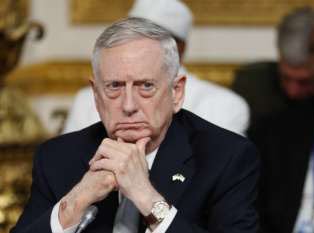
Defense Innovation Board takes on military personnel policies
As part of a draft set of recommendations, the Defense Innovation Board is exploring changes its members believe the Pentagon should make to its up-or-out promotion...
Subscribe to Federal Drive’s daily audio interviews on iTunes or PodcastOne
The Silicon Valley-centric panel in charge of advising the Pentagon on innovation says the military services are already filled to the brim with innovative thinkers. The problem is DoD’s processes don’t always let its best ideas rise to the top, and its personnel system tends to punish, not reward people, for thinking outside the box.
So, for its next project, the Defense Innovation Board is working on a set of recommendations that focuses on making changes to DoD’s personnel system and acquisition practices to help it become a quicker developer and adopter of innovative technologies.
The four recommendations are still in draft form, and board members intend to further refine them with specific actions the department should take before formally submitting them to the Pentagon, but several of them emphasize changes to the military personnel system.
“For all of us, the encouraging thing that there’s no shortage of innovative people who are forward leaning and care deeply about this institution and its capabilities,” said Jennifer Pahlka, a member of the Defense Innovation Board and the founder of Code for America. “DoD does not have an innovation problem. It has an innovation adoption problem.”
So, one of the recommendations is meant to harness more of those ideas by modifying the military’s personnel system, in particular, its up-or-out promotion system.
“It’s very limiting, because what it means is that people have to rotate through different positions that are designed specifically to make everybody interchangeable,” Pahlka said. “And one of the significant downsides of this system is that ideas that are innovative, that are going to help change and bring you the DoD into the 21st century are told to move on from those ideas instead of being able to pursue them and own them and carry them through to fruition.”
The recommendation would create a carve-out from the traditional personnel system — what the board calls an “elevator” — where a military member could stay in one position for longer periods of time and continue to work on a particular project with oversight and involvement from more senior officials.
The new status would require an approval process and what the board terms “executive sponsorship” from a DoD leader, but the member would be at least temporarily shielded from the competitive promotion process, including the potential of being involuntarily separated from service because of a failure to be selected for a higher rank.
“This is really not designed to train people to be innovative, it’s to empower the innovators that already exist in the military,” she said. “There are so many of them , and we need to tell them their ideas are valuable and pursue them.”
Another recommendation is specifically designed to bring more innovative talent into the armed services by creating new career branches dedicated to science, technology, engineering and math fields, much as the Army recently did for the cyber career field.
Board member Marne Levine, the chief operating officer at Instagram, said although DoD leaders overwhelmingly recognize the importance of STEM skills to a wide variety of disciplines, the military doesn’t have a career development pipeline specifically for those skills.
That hurts both the recruitment and retention of a high-tech workforce, she said.
“The department needs to demonstrate that it is a place where individuals can build careers in STEM. Without a clear and viable career path for STEM specialists, recruitment will continue to be an uphill battle, especially when these skills are in high demand in the private sector,” she said “We compete in the private sector fiercely for one with one another for the top engineers, computer scientists, software writers, coders and network administrators. And not only do we do this with significant resources at our disposal, we can offer individuals a career trajectory and promotion within their area of expertise.”
Levine argued that since DoD can’t compete on salary and can’t always assure service members a career in a STEM field, those who do have STEM skills become easy pickings for companies like hers.
Latest Defense News
“They become frustrated due to a lack of utilization and continued development, resulting in their talents being lost to the private sector,” she said. “And service members who have the opportunity to apply the skill sets on a limited basis are forced back to their basic branch in order to remain competitive for advancement. All of this seriously undermines the department’s ability to build the force that we need to address the emerging technological challenges that are changing the character of warfare.”
But board members argue it’s not enough to recruit and nurture innovative thinkers among the military’s rank and file.
To have a meaningful impact in prodding the department toward quickly adopting new technologies, senior leaders in and out of uniform need both the willingness and the knowledge to make DoD’s existing bureaucracies move faster, said Board Member Richard Murray, a professor at the California Institute of Technology.
“We’re asking how we make use of the various other transactions authorities and hiring authorities that have already been given,” he said. “Right now, when we ask people why they can’t do things, they tend to blame the Federal Acquisition Regulation, but there’s already a lot of flexibility. So how do we get people to use it? We think there may be a number of benefits by thinking about some sort of an education program modeled after the types of executive education that happens in business schools where you try and give people new insights about how to think about problems. We think that there are models that are out there, and we need to find ways to get leaders at all levels within the DoD to know more about what’s going on in the industry and to adopt some of those techniques that are working in industry.”
As part of a fourth recommendation, the board is looking for ways in which the department could set aside a subset of its key modernization priorities and develop them through an acquisition “accelerator” that’s less focused on cost than on speed.
The panel is still in talks with DoD about whether that new process would be an expansion of some of the alternative acquisition offices the department has already set up — like the Defense Innovation Unit Experimental and the Rapid Capabilities office — or something new entirely.
But Board Member Milo Medin, a vice president at Google Capital, says in either case, the process would be focused on a small number of cross-functional problems defined by the deputy secretary of Defense.
“That’s what we do in industry: when you’ve got a big problem in a company, you take your best folks from across that company, put those people on a tiger team and equip them with the decision making ability to actually execute,” he said. “We’re trying to figure out what the right mechanism is to accomplish that, and then be able to rapidly prototype, experiment and then go into production across the sort of valley of death that everyone normally talks about. It’s too ambitious to try and solve that problem for all systems, but the question is whether there are a certain set of problems that can be attacked reasonably this way. We have to change the pace of innovation in the department, and getting everybody focused on the right variable is going to yield good results if we can accomplish that.”
Copyright © 2025 Federal News Network. All rights reserved. This website is not intended for users located within the European Economic Area.
Jared Serbu is deputy editor of Federal News Network and reports on the Defense Department’s contracting, legislative, workforce and IT issues.
Follow @jserbuWFED





